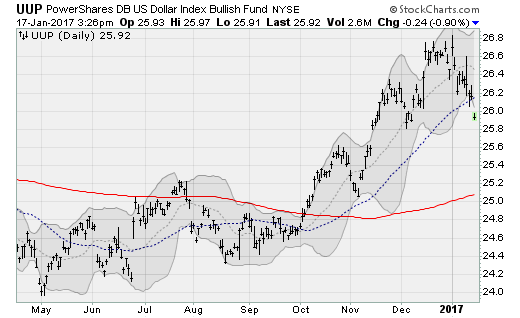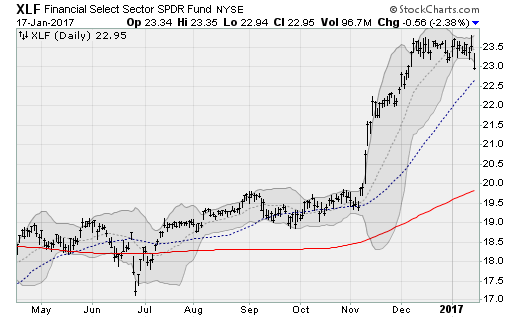Trump's dollar-bashing could chill Wall Street
U.S. equities were pushed lower on Tuesday as the post-election “Trump-flation” trade was partially unwound after the president-elect -- in an interview released over the holiday weekend -- said the U.S. dollar was “too strong” and thus jeopardized exports and the economy at large.
The result was a breakdown in the greenback from a multimonth uptrend, falling below its 50-day moving average for the first time since September. This, in turn, unleashed a wave of unwinding trades as familiar post-election momentum plays -- short Treasury bonds, long bank stocks and short precious metals -- suddenly reversed.
Strength in the greenback was the lynchpin of the three-month rally Wall Street has enjoyed (chart below), powered by optimism over Donald Trump’s fiscal stimulus plans and worries his “America first” policies would weigh on export-dependent countries like China and Mexico.
Thus, his willingness to talk down the dollar (a “verbal intervention” normally reserved for mercantilists with histories of currency manipulation in Asian countries like Japan and South Korea) has scrambled Wall Street’s recent playbook and puts Dow 20,000 further out of reach.
This is happening at the sector level as well: Financial stocks -- which have been the leaders of the post-election uptrend on hopes for deregulation and rising net interest margins associated with higher long-term yields -- were the laggards on Tuesday and risk breaking multimonth uptrends.
You can see this in the way the Financial Select SPDR (XLF) has broken below its lower Bollinger Band -- a measure of volatility -- for the first time since last June as it exits a two-month consolidation range (chart above). The market overall is holding up, however, with the Dow Jones industrials average still within 200 points of 20,000.
But that could actually be a warning sign.
Jason Goepfert at SentimenTrader noted that the last two times financial stocks moved to a one-month low -- as they did on Tuesday -- while the broad market remained near multiyear highs was in 1999 and 2007. Both times that marked the terminus of long bull markets.
Since 1965, when this has happened, stocks have on average been 3.4 percent lower one year later vs. an 8.1 percent average gain for any normal one-year period in the stock market.
Moreover, small-cap stocks have also rolled over to one-month lows. This, too, tends to presage further overall weakness.
Regarding the dollar, watch for the downtrend to continue as options traders have been betting aggressively on continued gains -- something that has, given the contrary nature of sentiment at extremes, led to pullbacks in the greenback.
This should continue to feed the recent uptick in volatility already seen in bond and currency markets and only now making its way into equities.






